P1: IML/FFX
Morgan-FM
P2: IML/FFX
QC: IML/FFX
T1: IML
MOBK037-Buso.cls
October 20, 2006
15:44
Digital Control in Power
Electronics
i
�
Copyright © 2006 by Morgan & Claypool
All rights reserved. No part of this publication may be reproduced, stored in a retrieval system, or transmitted in
any form or by any means—electronic, mechanical, photocopy, recording, or any other except for brief quotations
in printed reviews, without the prior permission of the publisher.
Digital Control in Power Electronics
Simone Buso and Paolo Mattavelli
www.morganclaypool.com
ISBN-10: 1598291122
ISBN-13: 9781598291124
paperback
paperback
ISBN-10: 1598291130
ISBN-13: 9781598291131
ebook
ebook
DOI10.2200/S00047ED1V01Y200609PEL002
A lecture in the Morgan & Claypool Synthesis Series
LECTURES ON POWER ELECTRONICS #2
Lecture #2
Series Editor: Jerry Hudgins, University of Nebraska-Lincoln
Series ISSN: 1930-9525
Series ISSN: 1930-9533
print
electronic
First Edition
10 9 8 7 6 5 4 3 2 1
Printed in the United States of America
�
P1: IML/FFX
Morgan-FM
P2: IML/FFX
QC: IML/FFX
T1: IML
MOBK037-Buso.cls
October 20, 2006
15:44
Digital Control in Power
Electronics
Simone Buso
Department of Information Engineering
University of Padova, Italy
Paolo Mattavelli
Department of Electrical, Mechanical and
Management Engineering
University of Udine, Italy
LECTURES ON POWER ELECTRONICS #2
M&C Morgan & Claypool Publishers
iii
�
P1: IML/FFX
Morgan-FM
P2: IML/FFX
QC: IML/FFX
T1: IML
MOBK037-Buso.cls
October 20, 2006
15:44
iv
ABSTRACT
This book presents the reader, whether an electrical engineering student in power electronics
or a design engineer, some typical power converter control problems and their basic digital
solutions, based on the most widespread digital control techniques. The presentation is focused
on different applications of the same power converter topology, the half-bridge voltage source
inverter, considered both in its single- and three-phase implementation. This is chosen as
the case study because, besides being simple and well known, it allows the discussion of a
significant spectrum of the more frequently encountered digital control applications in power
electronics, from digital pulse width modulation (DPWM) and space vector modulation (SVM),
to inverter output current and voltage control. The book aims to serve two purposes: to give
a basic, introductory knowledge of the digital control techniques applied to power converters,
and to raise the interest for discrete time control theory, stimulating new developments in its
application to switching power converters.
KEYWORDS
Digital control in power electronics, Discrete time control theory, Half-bridge voltage source
converters, Power converters, Power electronics
�
P1: IML/FFX
Morgan-FM
P2: IML/FFX
QC: IML/FFX
T1: IML
MOBK037-Buso.cls
October 20, 2006
15:44
v
Contents
1.
2.
Introduction: Digital Control Application to Power Electronic Circuits . . . . . . . . . . . .
1.1 Modern Power Electronics . . . . . . . . . . . . . . . . . . . . . . . . . . . . . . . . . . . . . . . . . . . . . . . . .
1.2 Why Digital Control . . . . . . . . . . . . . . . . . . . . . . . . . . . . . . . . . . . . . . . . . . . . . . . . . . . . . .
1.3 Trends and Perspectives . . . . . . . . . . . . . . . . . . . . . . . . . . . . . . . . . . . . . . . . . . . . . . . . . . . .
1.4 What is in this Book . . . . . . . . . . . . . . . . . . . . . . . . . . . . . . . . . . . . . . . . . . . . . . . . . . . . . . .
The Test Case: a Single-Phase Voltage Source Inverter. . . . . . . . . . . . . . . . . . . . . . . . . . . .
2.1 The Voltage Source Inverter . . . . . . . . . . . . . . . . . . . . . . . . . . . . . . . . . . . . . . . . . . . . . . . .
2.1.1
Fundamental Components . . . . . . . . . . . . . . . . . . . . . . . . . . . . . . . . . . . . . . . . . .
2.1.2 Required Additional Electronics: Driving and Sensing . . . . . . . . . . . . . . . . .
2.1.3
Principle of Operation . . . . . . . . . . . . . . . . . . . . . . . . . . . . . . . . . . . . . . . . . . . . . .
2.1.4 Dead-Times . . . . . . . . . . . . . . . . . . . . . . . . . . . . . . . . . . . . . . . . . . . . . . . . . . . . . . .
2.2 Low-Level Control of the Voltage Source Inverter: PWM Modulation . . . . . . . . .
2.2.1 Analog PWM: the Naturally Sampled Implementation . . . . . . . . . . . . . . . .
2.2.2 Digital PWM: the Uniformly Sampled Implementation . . . . . . . . . . . . . . .
2.2.3
Single Update and Double Update PWM Mode . . . . . . . . . . . . . . . . . . . . . .
2.2.4 Minimization of Modulator Delay: a Motivation
for Multisampling . . . . . . . . . . . . . . . . . . . . . . . . . . . . . . . . . . . . . . . . . . . . . . . . . .
2.3 Analog Control Approaches . . . . . . . . . . . . . . . . . . . . . . . . . . . . . . . . . . . . . . . . . . . . . . . .
2.3.1 Linear Current Control: PI Solution . . . . . . . . . . . . . . . . . . . . . . . . . . . . . . . . .
2.3.2 Nonlinear Current Control: Hysteresis Control . . . . . . . . . . . . . . . . . . . . . . .
3. Digital Current Mode Control . . . . . . . . . . . . . . . . . . . . . . . . . . . . . . . . . . . . . . . . . . . . . . . . . .
3.1 Requirements of the Digital Controller . . . . . . . . . . . . . . . . . . . . . . . . . . . . . . . . . . . . . .
3.1.1
Signal Conditioning and Sampling . . . . . . . . . . . . . . . . . . . . . . . . . . . . . . . . . .
3.1.2
Synchronization Between Sampling and PWM . . . . . . . . . . . . . . . . . . . . . . .
3.1.3 Quantization Noise and Arithmetic Noise . . . . . . . . . . . . . . . . . . . . . . . . . . . .
3.2 Basic Digital Current Control Implementations . . . . . . . . . . . . . . . . . . . . . . . . . . . . . .
3.2.1 The Proportional Integral Controller: Overview. . . . . . . . . . . . . . . . . . . . . . .
3.2.2
Simplified Dynamic Model of Delays . . . . . . . . . . . . . . . . . . . . . . . . . . . . . . . .
3.2.3 The Proportional Integral Controller: Discretization Strategies . . . . . . . . .
3.2.4 Effects of the Computation Delay . . . . . . . . . . . . . . . . . . . . . . . . . . . . . . . . . . .
�
P1: IML/FFX
Morgan-FM
P2: IML/FFX
QC: IML/FFX
T1: IML
MOBK037-Buso.cls
October 20, 2006
15:44
vi CONTENTS
3.2.5 Derivation of a Discrete Time Domain Converter Dynamic Model . . . . .
3.2.6 Minimization of the Computation Delay . . . . . . . . . . . . . . . . . . . . . . . . . . . . .
3.2.7 The Predictive Controller . . . . . . . . . . . . . . . . . . . . . . . . . . . . . . . . . . . . . . . . . . .
Extension to Three-Phase Inverters . . . . . . . . . . . . . . . . . . . . . . . . . . . . . . . . . . . . . . . . . . . . .
4.1 The αβ Transformation . . . . . . . . . . . . . . . . . . . . . . . . . . . . . . . . . . . . . . . . . . . . . . . . . . . .
Space Vector Modulation . . . . . . . . . . . . . . . . . . . . . . . . . . . . . . . . . . . . . . . . . . . . . . . . . .
4.2
4.2.1
Space Vector Modulation Based Controllers . . . . . . . . . . . . . . . . . . . . . . . . . .
4.3 The Rotating Reference Frame Current Controller . . . . . . . . . . . . . . . . . . . . . . . . . . .
4.3.1
Park’s Transformation . . . . . . . . . . . . . . . . . . . . . . . . . . . . . . . . . . . . . . . . . . . . . .
4.3.2 Design of a Rotating Reference Frame PI Current Controller . . . . . . . . . .
4.3.3 A Different Implementation of the Rotating Reference Frame
PI Current Controller . . . . . . . . . . . . . . . . . . . . . . . . . . . . . . . . . . . . . . . . . . . . . .
5.2.1
External Control Loops . . . . . . . . . . . . . . . . . . . . . . . . . . . . . . . . . . . . . . . . . . . . . . . . . . . . . . . . .
5.1 Modeling the Internal Current Loop . . . . . . . . . . . . . . . . . . . . . . . . . . . . . . . . . . . . . . . .
5.2 Design of Voltage Controllers . . . . . . . . . . . . . . . . . . . . . . . . . . . . . . . . . . . . . . . . . . . . . .
Possible Strategies: Large and Narrow Bandwidth Controllers . . . . . . . . . .
5.3 Large Bandwidth Controllers . . . . . . . . . . . . . . . . . . . . . . . . . . . . . . . . . . . . . . . . . . . . . . .
5.3.1
PI Controller . . . . . . . . . . . . . . . . . . . . . . . . . . . . . . . . . . . . . . . . . . . . . . . . . . . . . .
5.3.2 The Predictive Controller . . . . . . . . . . . . . . . . . . . . . . . . . . . . . . . . . . . . . . . . . . .
5.4 Narrow Bandwidth Controllers . . . . . . . . . . . . . . . . . . . . . . . . . . . . . . . . . . . . . . . . . . . . .
5.4.1 The Repetitive-Based Voltage Controller . . . . . . . . . . . . . . . . . . . . . . . . . . . . .
5.4.2 The DFT Filter Based Voltage Controller . . . . . . . . . . . . . . . . . . . . . . . . . . . .
5.5 Other Applications of the Current Controlled VSI. . . . . . . . . . . . . . . . . . . . . . . . . . . .
5.5.1 The Controlled Rectifier . . . . . . . . . . . . . . . . . . . . . . . . . . . . . . . . . . . . . . . . . . . .
5.5.2 The Active Power Filter . . . . . . . . . . . . . . . . . . . . . . . . . . . . . . . . . . . . . . . . . . . .
Conclusions. . . . . . . . . . . . . . . . . . . . . . . . . . . . . . . . . . . . . . . . . . . . . . . . . . . . . . . . . . . . . . . . . . . .
About the Authors . . . . . . . . . . . . . . . . . . . . . . . . . . . . . . . . . . . . . . . . . . . . . . . . . . . . . . . . . . . . . .
4.
5.
6.
7.
�
P1: IML/FFX
MOBK037-01
P2: IML/FFX
MOBK037-Buso.cls
QC: IML/FFX
T1: IML
October 20, 2006
15:36
1
C H A P T E R 1
Introduction: Digital Control
Application to Power Electronic
Circuits
Power electronics and discrete time system theory have been closely related to each other from
the very beginning. This statement may seem surprising at first, but, if one thinks of switch
mode power supplies as variable structure periodic systems, whose state is determined by logic
signals, the connection becomes immediately clearer. A proof of this may also be found in
the first, fundamental technical papers dealing with the analysis and modeling of pulse width
modulated power supplies or peak current mode controlled dc–dc converters: they often provide
a mathematical representation of both the switching converters and the related control circuits,
resembling or identical to that of sampled data dynamic systems.
This fundamental contiguousness of the two apparently far areas of engineering is probably
the strongest, more basic motivation for the considerable amount of research that, over the
years, has been dedicated to the application of digital control to power electronic circuits. From
the original, basic idea of implementing current or voltage controllers for switching converters
using digital signal processors or microcontrollers, which represents the foundation of all current
industrial applications, the research focus has moved to more sophisticated approaches, where
the design of custom integrated digital controllers is no longer presented like an academic
curiosity, but is rather perceived like a sound, viable solution for the next generation of high-
performance power supplies.
If we consider the acceleration in the scientific production related to these topics in the
more recent years, we can easily anticipate, for a not too far ahead future, the creation of
energy processing circuits, where power devices and control logic can be built on the same
semiconductor die. From this standpoint, the distance we see today between the tools and the
design methodology of power electronics engineers and those of analog and/or digital integrated
circuit designers can be expected to significantly reduce in the next few years.
�
P1: IML/FFX
MOBK037-01
P2: IML/FFX
MOBK037-Buso.cls
QC: IML/FFX
T1: IML
October 20, 2006
15:36
2 DIGITAL CONTROL IN POWER ELECTRONICS
We have to admit that, in this complex scenario, the purpose of this book is very sim-
ple. We just would like to introduce the reader to basic control problems in power electronic
circuits and to illustrate the more classical, widely applied digital solutions to those problems.
We hope this will serve two purposes: first, to give a basic, introductory knowledge of the
digital control techniques applied to power converters, and second, to raise the interest for dis-
crete time control theory, hopefully stimulating new developments in its application to power
converters.
MODERN POWER ELECTRONICS
1.1
Classical power electronics may be considered, under several points of view, a mature discipline.
The technology and engineering of discrete component based switch mode power supplies
are nowadays fully developed industry application areas, where one does not expect to see
any outstanding innovation, at least in the near future. Symmetrically, at the present time,
the research fields concerning power converter topologies and the related conventional, analog
control strategies seem to have been thoroughly explored.
On the other hand, we can identify some very promising research fields where the future
of power electronics is likely to be found. For example, a considerable opportunity for innovation
can be expected in the field of large bandgap semiconductor devices, in particular if we consider
the semiconductor technologies based on silicon carbide, SiC, gallium arsenide, GaAs, and
gallium nitride, GaN. These could, in the near future, prove to be practically usable not only for
ultra-high-frequency amplification of radio signals, but also for power conversion, opening the
door to high-frequency (multi-MHz) and/or high-temperature power converter circuits and,
consequently, to a very significant leap in the achievable power densities.
The rush for higher and higher power densities motivates research also in other directions.
Among these, we would like to mention three that, in our vision, are going to play a very
significant role. The first is the integration in a single device of magnetic and capacitive passive
components, which may allow the implementation of minimum volume, quasi monolithic,
converters. The second is related to the analysis and mitigation of electromagnetic interference
(EMI), which is likely to become fundamental for the design of compact, high frequency,
converters, where critical autosusceptibility problems can be expected. The third one is the
development of technologies and design tools allowing the integration of control circuits and
power devices on the same semiconductor chip, according to the so-called smart power concept.
These research areas represent good examples of what, in our vision, can be considered modern
power electronics.
From this standpoint, the application of digital control techniques to switch mode power
supplies can play a very significant role. Indeed, the integration of complex control func-
tions, such as those that are likely to be required by the next generation power supplies,
�
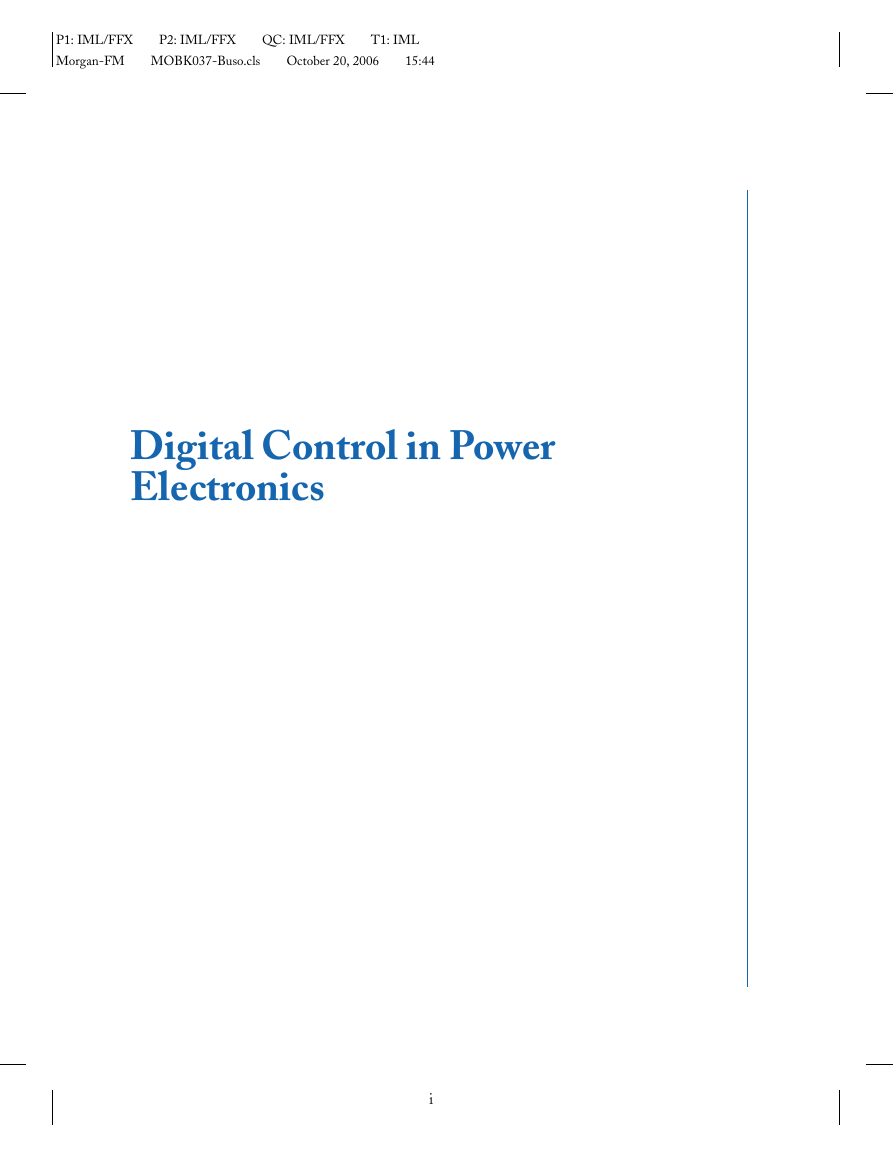
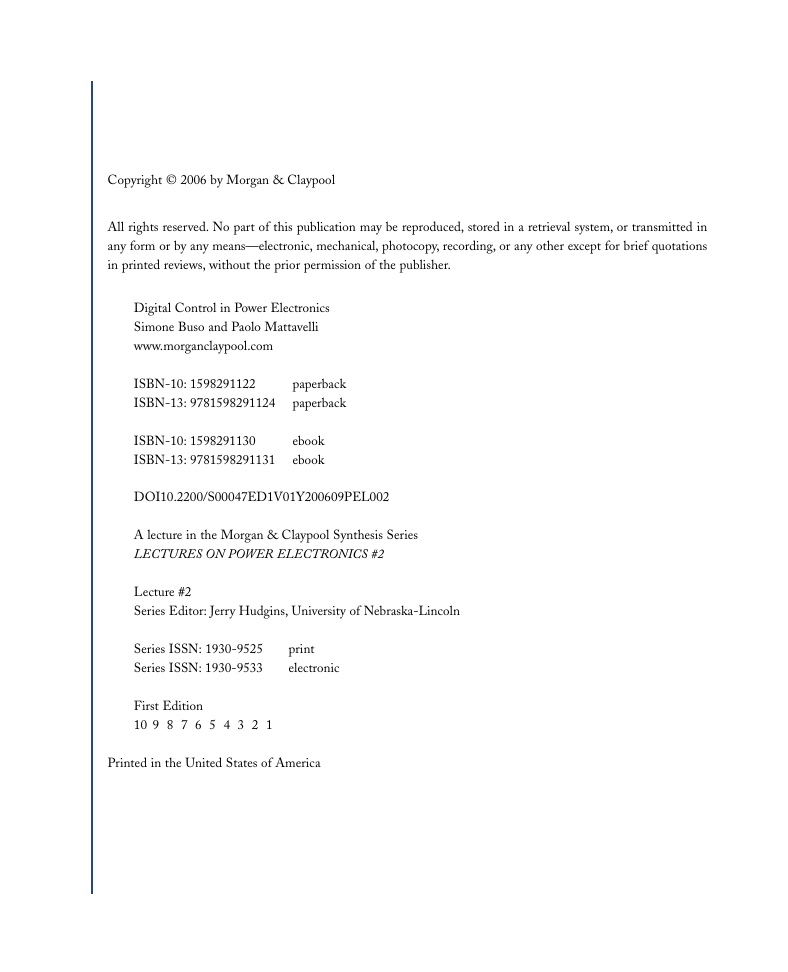
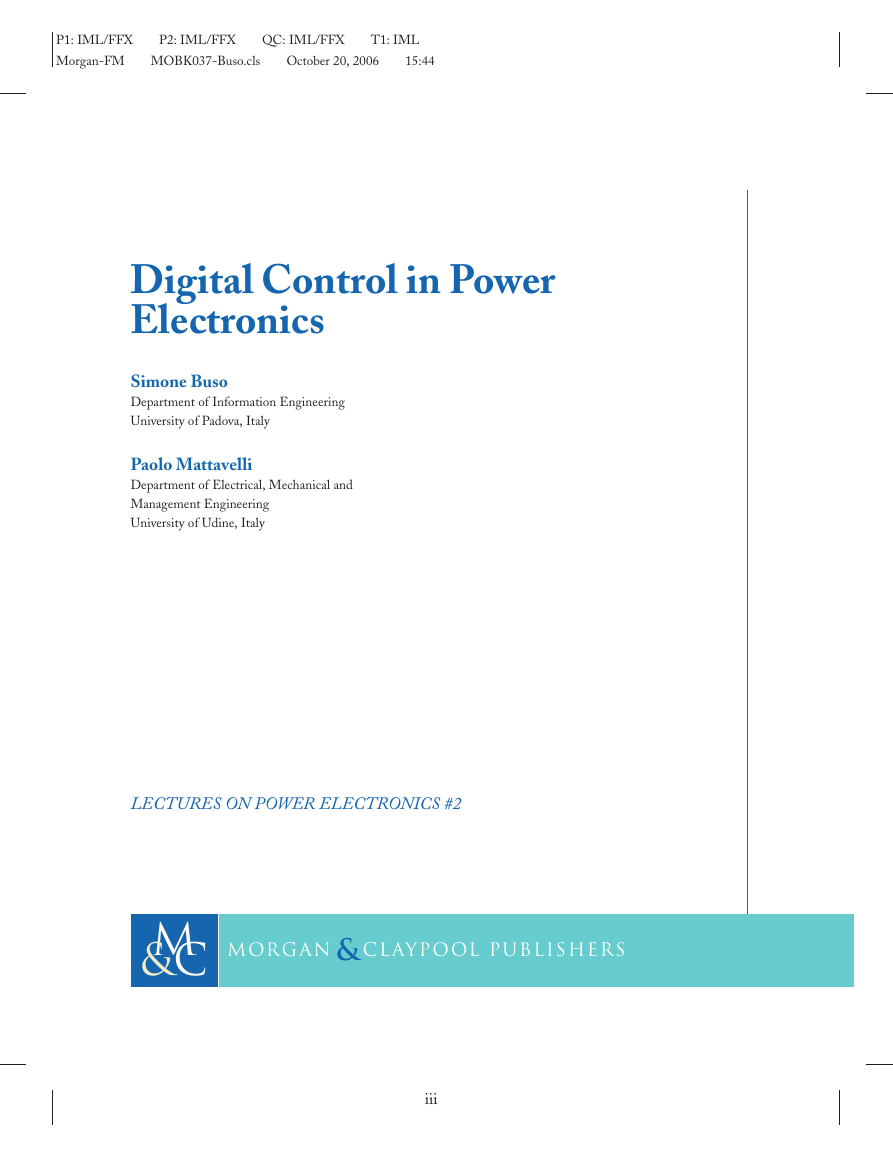
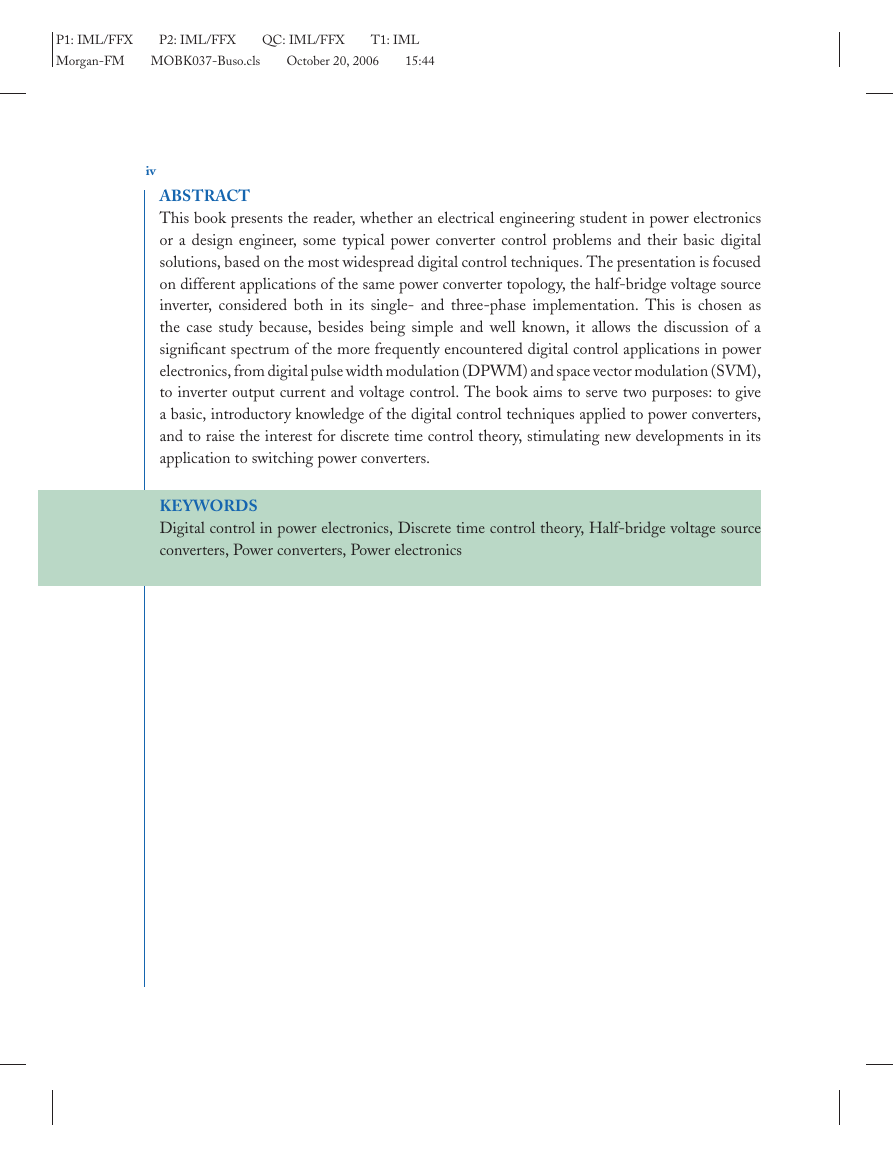

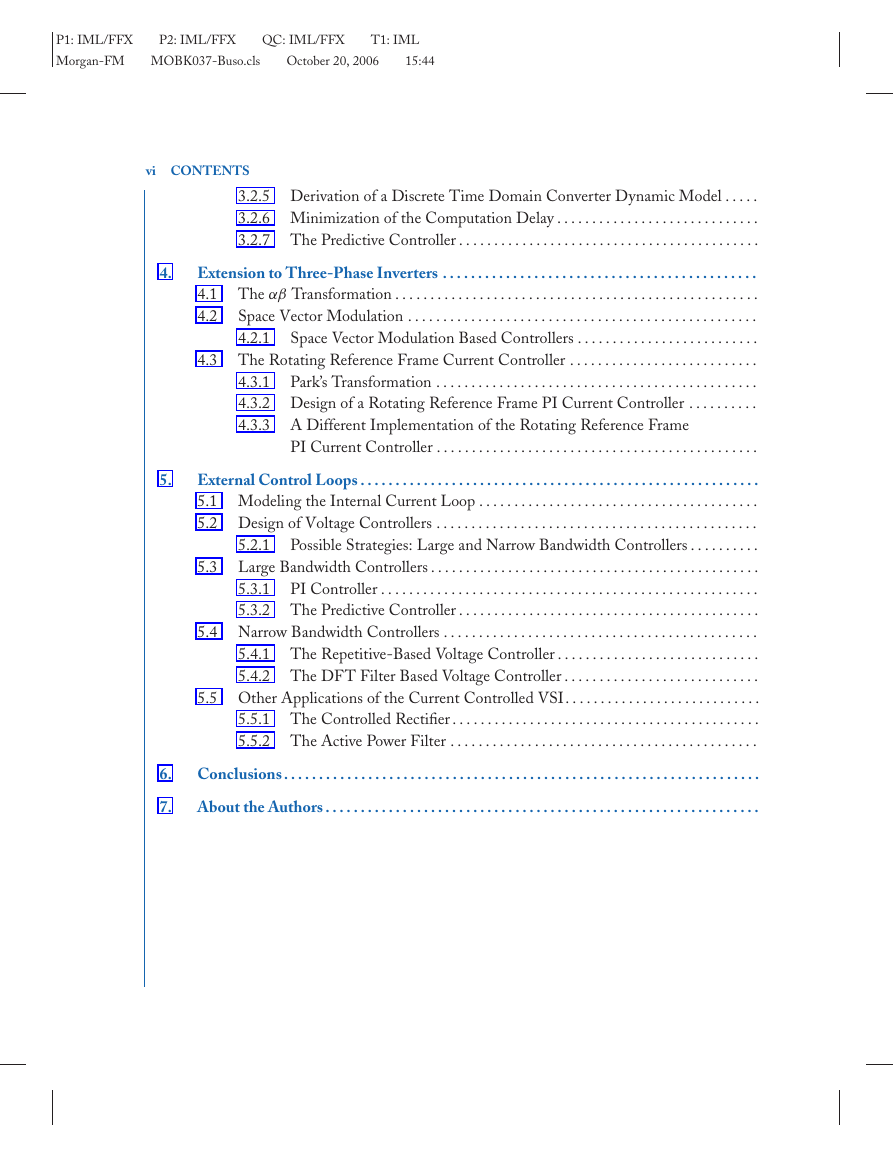
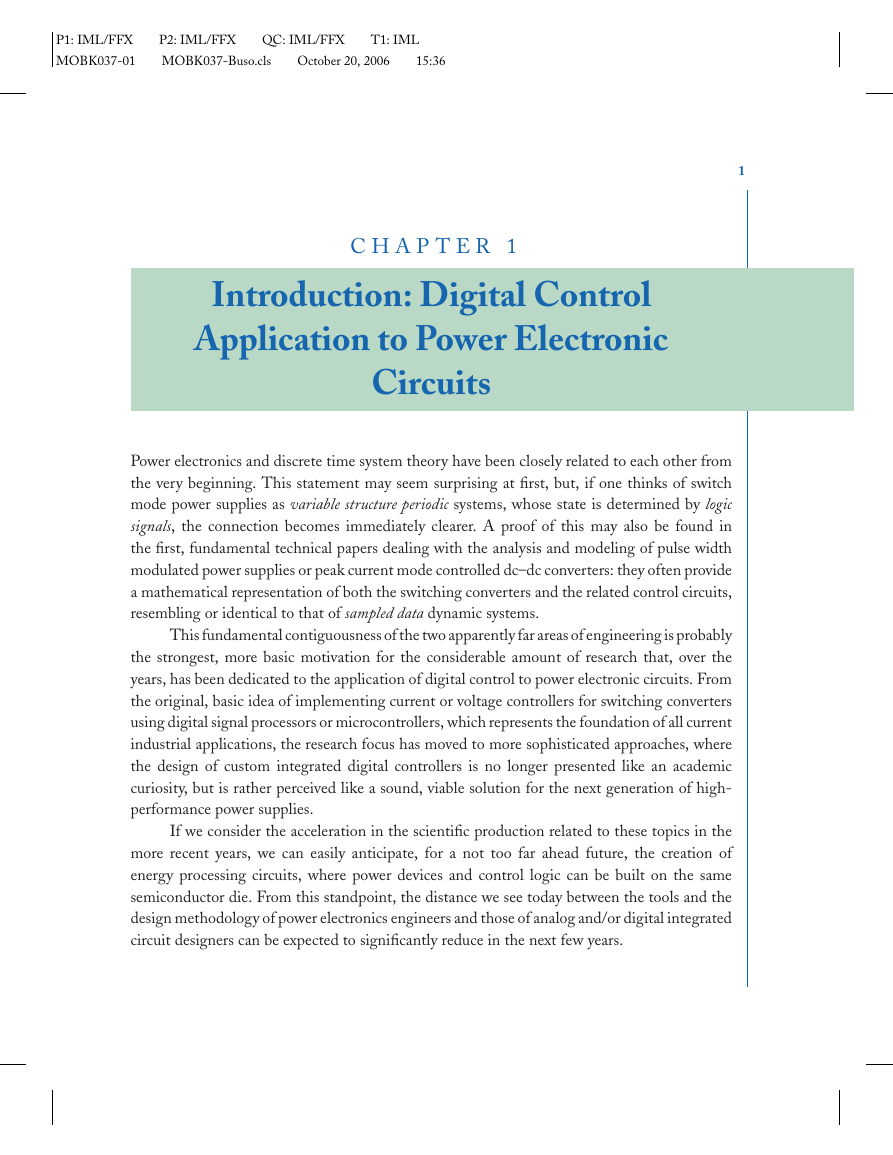
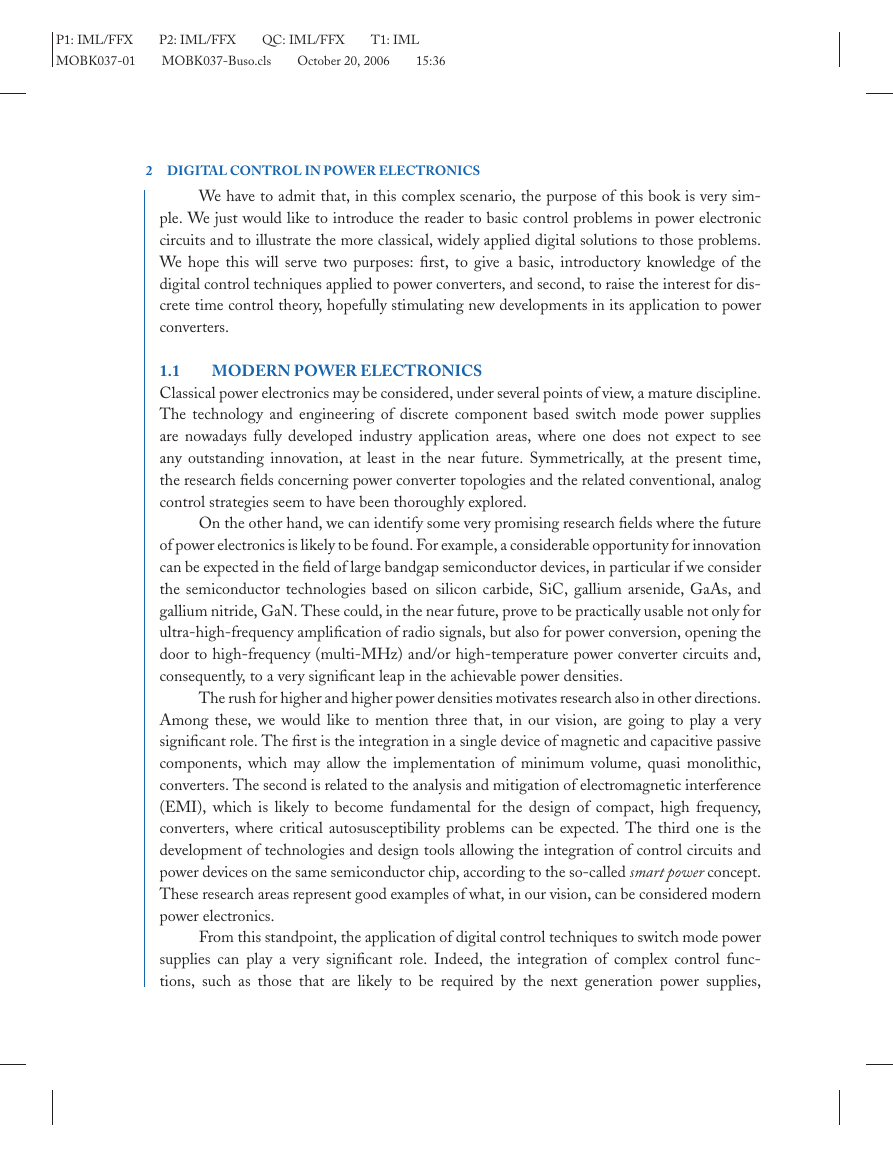








 2023年江西萍乡中考道德与法治真题及答案.doc
2023年江西萍乡中考道德与法治真题及答案.doc 2012年重庆南川中考生物真题及答案.doc
2012年重庆南川中考生物真题及答案.doc 2013年江西师范大学地理学综合及文艺理论基础考研真题.doc
2013年江西师范大学地理学综合及文艺理论基础考研真题.doc 2020年四川甘孜小升初语文真题及答案I卷.doc
2020年四川甘孜小升初语文真题及答案I卷.doc 2020年注册岩土工程师专业基础考试真题及答案.doc
2020年注册岩土工程师专业基础考试真题及答案.doc 2023-2024学年福建省厦门市九年级上学期数学月考试题及答案.doc
2023-2024学年福建省厦门市九年级上学期数学月考试题及答案.doc 2021-2022学年辽宁省沈阳市大东区九年级上学期语文期末试题及答案.doc
2021-2022学年辽宁省沈阳市大东区九年级上学期语文期末试题及答案.doc 2022-2023学年北京东城区初三第一学期物理期末试卷及答案.doc
2022-2023学年北京东城区初三第一学期物理期末试卷及答案.doc 2018上半年江西教师资格初中地理学科知识与教学能力真题及答案.doc
2018上半年江西教师资格初中地理学科知识与教学能力真题及答案.doc 2012年河北国家公务员申论考试真题及答案-省级.doc
2012年河北国家公务员申论考试真题及答案-省级.doc 2020-2021学年江苏省扬州市江都区邵樊片九年级上学期数学第一次质量检测试题及答案.doc
2020-2021学年江苏省扬州市江都区邵樊片九年级上学期数学第一次质量检测试题及答案.doc 2022下半年黑龙江教师资格证中学综合素质真题及答案.doc
2022下半年黑龙江教师资格证中学综合素质真题及答案.doc